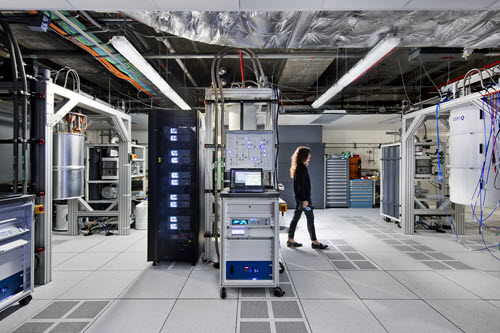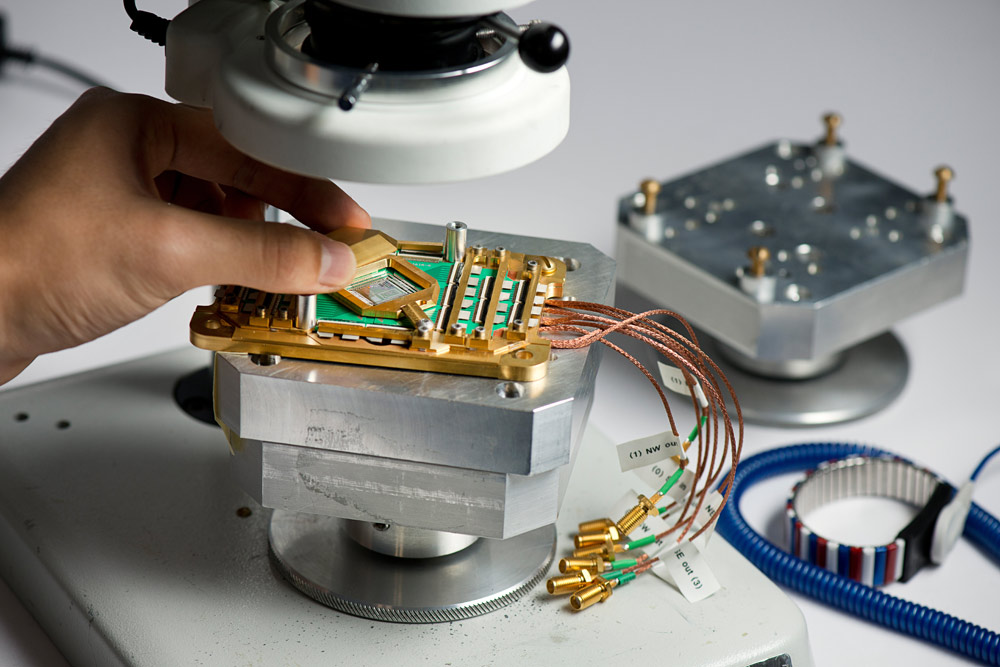A few days ago, several media outlets reported that a leaked paper from Google — one that was uploaded to the NASA website, but shortly taken down — alleged that the company had achieved “quantum supremacy“. It had run a calculation that would take the world’s fastest supercomputer 10,000 years to run in just over three minutes. Expert opinions on this claim vary, but what experts broadly do agree on is the certainty that quantum computers will one day reign supreme in the area of computation.
Quantum computers promise to take compute power to all new levels of performance, so the hype around them is understandable. However, the hype also means that just about every discussion of quantum computing inevitably includes the question, “When can I buy a quantum laptop/tablet/device?”
And the disappointing answer is: not for a long time. While the concept of quantum computing has been around for decades, the technology is simply too new and under development – so much so that a running tech-industry joke is that commercial quantum computing has been “at least ten years away” every year for the last ten years.
That doesn’t mean quantum computing is inaccessible, or that your business can’t leverage it in some way. That said, there’s a chance your business doesn’t even need it right now – quantum computing lends itself to certain types of apps more than others for the simple reason that classic computers can handle most business apps and processes that enterprises need.
If your enterprise happens to fit that description, the bad news is that you probably can’t afford your own quantum computer. The good news is that you can rent one via the cloud.
What is a quantum computer anyway?
The first step is, of course, getting to grips with what makes a quantum computer different from classical computers. For that, I strongly recommend this Wired tutorial, in which Dr Talia Gershon, senior manager for quantum research at IBM, explains quantum computing to five different people at various levels of education, from an eight-year-old kid to a computer professional. It’s especially helpful if you’re unfamiliar with the concept of quantum physics.
The TL;DR version goes like this:
Where classic computers use binary bits (1s or 0s), quantum computers use ‘qubits’, which can potentially be both at the same time. This is called ‘superpositioning’. Another quantum property called ‘entanglement’ enables qubits to be linked to each other, so that they become a multidimensional system of qubits.
When you combine superpositioning and entanglement, this essentially enables quantum computers to process and solve problems much faster than standard computers, and in parallel with each other, so that it can calculate a huge number of possible outcomes simultaneously.
This is even harder to do than it sounds, not least because it requires stable qubits. This is key because qubits by nature are in dual states simultaneously, which makes them incredibly sensitive to any outside disturbances such as electrical fields and heat. This is why quantum computers have to be supercooled to close to absolute zero – not because the processors run hotter, but because it’s the only way to keep qubits stable long enough to actually calculate anything useful, after which they have to be reset.
Functional quantum computers have been built by big tech players like Alibaba Cloud, Google, IBM and Intel, as well as start-ups like D-Wave and Rigetti. However, for the most part they’re confined to R&D labs and research centers, with a major focus of the research being how to build a more stable (and monetizable) quantum computer.
Fragmented hardware
Indeed, says Mark Horvath, senior director analyst of Gartner, even the hardware for quantum computers is still being sorted out.
“There’s not one set of hardware that everybody agrees on, where all we have to do is put a language on top of it and abstract the hardware through an abstraction layer,” he said in a recent Gartner webinar on quantum computing. “Instead, there’re multiple different platforms, and they’re specialized – each one does something a little bit better, a little bit different than everybody else.”
In fact, there are eight categories of quantum computing hardware being explored by universities and vendors. While none command a solid majority of research activity, Gartner estimates that superconducting circuits are the biggest category (27%), which is where companies like IBM and Google are focused. Other hardware categories include photonics (18%), adiabatic (11%), trapped ions (11%) topological (7%), nitrogen-vacancy (NV) diamond (7%) and neutral atoms (5%).
Xanadu AI is leading research on photonics, while Intel is looking at quantum dots, ionQ is trapping ions, and topological solutions are being driven by Microsoft and Bell Labs. Quantum Diamond Technologies is exploring NV diamond computers, which don’t require supercooling but are extremely difficult to fabricate.
For enterprises, the important thing to know isn’t how each of these work, but the fact that quantum computing hardware is currently highly fragmented and specialized.
For example, D-Wave leverages adiabatic quantum computing to build quantum annealers, which are related to but different from the gate-model quantum computers being pursued by other firms. The technical details are mind-boggling if you don’t understand quantum mechanics, but as this D-Wave video explains, the fundamental difference is control. Simply put, quantum annealing solves problems by allowing the qubits to take their natural evolutionary course in finding the answer, whereas with gate-model quantum computing, the objective is to control and manipulate the process.
What that means in practical terms is that while gate-model quantum computing can solve all kinds of problems, it’s also much more difficult to develop. Quantum annealing is designed primarily for specific problems like optimization and probabilistic sampling, and because it doesn’t require the same amount of control, it’s easier to get qubits to work together coherently.

That also means quantum annealers can support far more qubits than gate-model quantum computers. For reference, earlier this year D-Wave announced its next-generation Pegasus platform supports over 5,000 qubits. In September this year, IBM announced it would be soon unveiling a new 53-qubit quantum computer, its most powerful to date.
The upshot of all this is that mass production of quantum computers isn’t happening anytime soon, and buying your own will be insanely expensive. Even if you could afford one, you would need to hire people qualified to operate it, says Martin Reynolds VP and distinguished analyst at Gartner. “If you’re running quantum computers, you need physicists,” he said. “You need people in lab coats who understand how these things work.”
At the very least you’ll need quantum algorithm experts and designers, as well as quantum circuit designers, to cover all the bases of operating a quantum computer. And you’ll likely have to rent these out from specialist consultant companies such as 1Qbit, Entropica Labs, Entanglement Partners, High Bar Quantum Consultants, Qilimanjaro, QxBranch, Strange Works and Zapata, among others.
Do you really need a quantum computer?
That’s probably as well because most enterprises probably won’t need their very own quantum computer anyway. Quantum computers aren’t meant to replace classical computers – their purpose is to solve highly specialized problems that classical computers can’t handle. And for now, these tend to be applicable to very specific industries.
For example, says Horvath of Gartner, quantum computers are currently being used for things like material science and chemistry.
“These are physical problems, where we’re taking compounds and atoms and simulating them on the quantum computer to see what else we can do with them to see if there are solvable states that we can learn from or using our research,” he said.
Those apps also feed into other areas like personalized medicine and biomimetics, he added. “Looking at how those drug interactions work, pharmacology, and very complex problems like protein folding are all part of these set of solutions that are being investigated today with quantum computing.”
Obviously, those apps are only useful for companies linked to those industries. However, one current app with cross-industry appeal is solving optimization problems, which involves looking for the best possible outcome to a given set of conditions. D-Wave’s simplified go-to example for this is a scenario where you’re building a dream house but your budget doesn’t allow you to put in everything you want – so the optimization problem is how to include as many items as possible in your house without exceeding your budget.

Quantum computers – and annealers in particular – can handle these kinds of problems at scales where the number of elements impacting the outcome are massive. D-Wave says its system has been used by researchers for a number of real-world optimization problems. For example, Volkswagen conducted a project for calculating taxi traffic optimization in Beijing. Recruit Communications looked for ways to optimize the efficiency of matching advertisements to customers for web advertising. And the Roswell Park Cancer Institute used optimization to develop more accurate radiation therapy that can kill cancerous cells without touching healthy ones.
Other possible quantum computing apps include improving artificial intelligence and machine learning, finance apps (for optimizing high-frequency trading, for instance) and DNA gene sequencing.
Quantum computing as a service
Obviously, applying quantum computing to any problem requires actually getting your hands on a quantum computer – which, as mentioned above, is not something you can just go out and buy even if you have as much money as Jeff Bezos.
The good news is that you can rent one via the cloud.
Companies like Alibaba Cloud, D-Wave and Rigetti already allow academic researchers and paying customers to access their quantum computers via the cloud – IBM will join that list when its upcoming 53-qubit machine goes online.
Some use them for the apps listed above, but many simply play around with them to get the hang of quantum computing, demystify it and generally get a sense of what they might do with that capability.
Helpfully, there are plenty of quantum software SDKs available that are designed for that purpose. D-Wave, IBM, Microsoft, Rigetti and Xanadu offer SDKs, and there are also open-source options like Project Q from the University of Zurich. The aforementioned Gartner webinar included demos of the D-Wave and IBM SDKs, and they’re relatively easy to use. If you work with Python, you should be able to handle them.
In any case, the cloud is expected to the only route to quantum computing for most enterprises. According to an August report from Inside Quantum Technology, “all but the largest businesses will access quantum through quantum clouds such as those currently available from IBM and D-Wave.”
The report forecasts that quantum cloud services are expected to generate over $740 million in revenues by 2029. Gartner estimates that while 20% of organizations will be budgeting for quantum computing projects (compared to less than 1% today), 95% of organizations who are researching quantum computing strategies in 2023 will be using cloud-based quantum computing services.
















